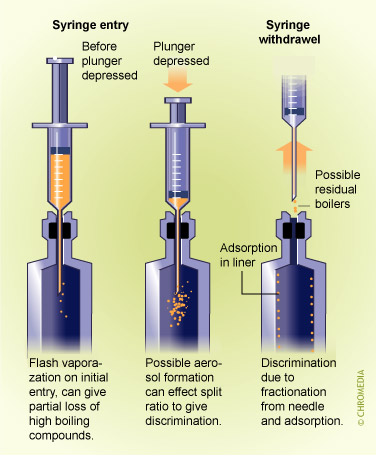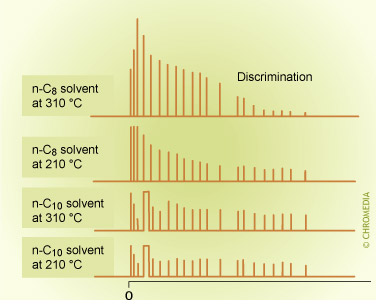Most samples for GC are in a liquid state after being dissolved or diluted in a volatile solvent. These are then introduced into the injector by using a microlitre volume syringe containing the appropriate sample volume (usually 0.1 to 1 µL). This is injected by inserting the syringe needle through a self-sealing septum consisting of a thermally stable silicone rubber.
For manual syringe injection, the following general procedure is recommended:
- Draw the required sample volume into the syringe.
- Withdraw the plunger slightly. For plunger in needle syringes this should be by approximately 1cm to leave an air gap between the bottom of the needle and the sample.
- Quickly wipe the outside of the needle with a clean tissue.
- Insert the needle into the septum and push it to the full depth. Depress the plunger and withdraw the syringe as quickly as possible. For certain applications, especially if very high-boiling compounds are involved, the repeatability can be improved by leaving the syringe in the hot injector for a few seconds after the actual injection.
Syringe discrimination effects
Manual injection is undoubtedly one of the biggest causes of variation in practice, particularly when different operators are compared.
Although the use of autosamplers can significantly reduce human error, there are some remaining inherent problems that are associated with the injection of liquid samples into hot injectors.
Syringe injection is inherent to a number of problems:
- Vaporisation of sample in the needle
Part of the sample that is present inside the needle can start to vaporize immediately, even before the plunger is depressed. Although this is not a problem for most samples, very high boiling components may either distill slowly from the needle, or they may vaporize and recondense in the cooler upper regions of the needle.
- Sample discrimination
Disproportionation of the sample can occur when sample components are partially retained by the syringe upon injection onto the column. This is called sample discrimination and can cause considerable error in some analyses.
- Sample transfer
Another major problem with regard to syringe handling is the transfer of the minute quantity of liquid sample to the GC in an accurate and known amount. Fortunately, the use of the internal standard procedure usually eliminates errors arising from this source.
Syringe handling should be consistent if a high level of precision is required, and this is best ensured by using an autosampler.
Injection needle discrimination
Injection speed OCI
Any injection technique that involves the conversion of the sample to its vapor before it reaches the column is known as a vaporization technique. This vaporization process is usually carried out very quickly as a flash vaporization and this usually means that the syringe needle has to enter a very hot zone.
Modern injectors can be operated at temperatures of up to about 400 °C, which is sufficient to volatilize samples boiling at least to 500 °C. On-column injection, which does not involve initial vaporization of the sample, is nevertheless recommended wherever possible and particularly for high boiling samples. Users should beware of using very high injector temperatures that may cause pyrolysis of the sample. Finally, high injector temperatures will also reduce the lifetime of the septum.
| The syringe should always be handled with care to ensure the quality of the analysis and to ensure the lifetime of the syringe. Store syringes in their original packing when not in use, or place them in a syringe rack during the analyses. |
| Cleaning the syringe should be a matter of routine. Rinse regularly with a clean, non-aggressive solvent to avoid blockage and contamination of new samples by previous samples (sample carry-over). This is especially true for trace analyses at high detector sensitivities. |
 Did you ever try to explain separation to your employees or students? Well, try no more: Lee Polite did it for you in a way which is hard to beat. We will open up one example of his whiteboard class.
Did you ever try to explain separation to your employees or students? Well, try no more: Lee Polite did it for you in a way which is hard to beat. We will open up one example of his whiteboard class. 




